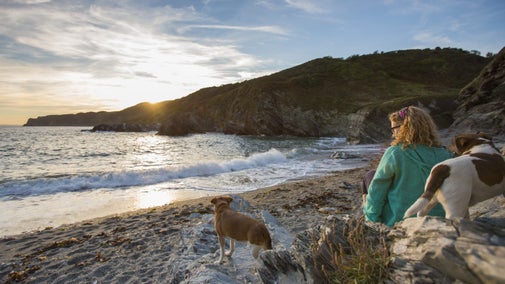
Discover more at Godrevy
Find out when how to get to Godrevy, the things to see and do and more.

Whatever your interest, there’s sure to be an activity for you at Godrevy. Miles of golden sands, beginner-friendly surfing conditions, clifftop walks across wild heathlands and lots of wildlife-watching opportunities make this a natural playground for both young and old.
The North Cornwall coast is famed for its surfing beaches, and Godrevy is right up there with the best of them. Working through most tides, the beach is especially popular with learner surfers thanks to its soft-breaking waves. However, when the swell is over 4ft and the wind is anything other than perfect – light, offshore – it can be a long and challenging paddle to get out the back. Like most beach breaks, it relies heavily on the quality of its sand banks to provide long, walled-up rides.
Want to learn how to surf? Then try one of these:
At low tide, the magnitude of Godrevy beach is revealed. At the northern end of St Ives Bay, the three miles of golden sand stretches from Hayle around the bay to Godrevy Cove.
Please remember to check the tides, as some areas of the beach can get cut off at high tide. You can check the weather and tide times easily online.
The lifeguard service is seasonal. Please swim between the flags and follow all instructions from the guards.
Dogs are only allowed on the beach from before 1 July and after 31 August. However, they're welcome on the walking routes on the headland all year round.
Please pick up after your dog and take all your litter home with you.

There are many resident and breeding birds at Godrevy, meaning there’s something to see all year round.
During the spring and autumn, the headland around Godrevy and the nearby Knavocks is a prime spot for watching visible migration. Pipits, finches, wheatears and swallows can pass through in high numbers on the right day. There’s even a good chance of a peregrine falcon showing up.
The ‘rarity list’ of birds is impressive, too. It includes woodchat shrikes, red-rumped swallows, American robins, barred warblers, Richard’s pipits, black-winged stilts, upland sandpipers and killdeers.
If a northerly gale is howling, we suggest taking a telescope to scan the sea for passing seabirds, such as Manx and sooty shearwaters, skuas and storm petrels.

Godrevy is home to grey seals, which can often be seen in the sea or resting on the beach. As the tide drops, they come onto land – known as 'hauling out' – to rest, digest their food, moult and look after their pups. They won’t usually leave until the water forces them to float off again.
If you do spot any seals, please take care not to worry or disturb them by following the seal watching guidelines:
Geocaching is a treasure hunt with a difference, as it's more about the hunt than the pot of gold at the end. It's a great way to enjoy the freedom of being outside and discovering new places.
There are several geocaches hidden around Godrevy, and all you need to find them is a handheld GPS or an app on a smartphone.
Find out more on geocaching.com. Follow the instructions and see if you can find some of the caches in the area. Hint: they’re in small, waterproof treasure boxes.
So, once you’ve found the treasure box, what will you find inside? Most caches have a logbook for you to leave a message in, and the satisfaction of finding the box is a reward in itself.
Often, you'll also find a strange array of trinkets that people have left to swap. If you take a treasure out of the box, you should leave another trinket in its place, so come prepared.
Walk across the Godrevy headland in spring and you'll be met with an extraordinary sight: a sea of purple Phacelia. Visible from all across Carbis Bay, these super-pollinating flowers were introduced to attract wildlife and – once they've broken down – act as fertile manure for follow-on crops. But they also happen to be very photogenic.

Between June and late July, you may be able to spot the silver-studded blue butterflies that live on the heathland at Godrevy. They’re a rare species, confined to a few small colonies in England and Wales. The adults roost together, which can be a lovely sight if you catch them early enough in the morning.
You might see other species, too, including common blue, meadow brown, gatekeeper, small heath, peacock, wall brown and dark green fritillary. Occasionally, migrant species such as painted lady and red admiral also appear.

Find out when how to get to Godrevy, the things to see and do and more.
There are miles of natural beautiful coastline and beaches in Cornwall to explore with all the family. There's plenty of space to blow away the cobwebs along the coast.

Discover what to consider when planning your visit to this sandy beach and its surrounding headland, including what facilities are available and the best places to park.

From managing the heathlands to creating new pathways, discover how National Trust rangers are helping Godrevy to thrive – and how the Shetland ponies are playing their part, too.

Learn how the National Trust is working to combat the increasing threat of coastal erosion at Godrevy, and why action needs to be taken.
Discover the 890 miles of beautiful coastline in our care. Plan your next coastal adventure, whether you want to explore soft, sandy beaches or rugged, windswept cliffs.

Try out the ‘50 things to do before you’re 11¾’ activities children can enjoy by the sea, from paddling or swimming, to catching crabs and skimming stones.

While canoeing and kayaking are great ways to experience nature and keep fit, they can be dangerous if you don't follow the guidelines. Learn how to stay safe with our advice and guidance.
